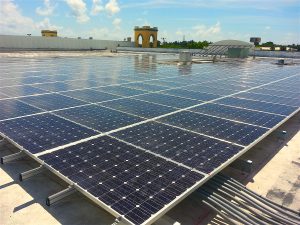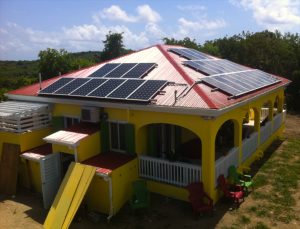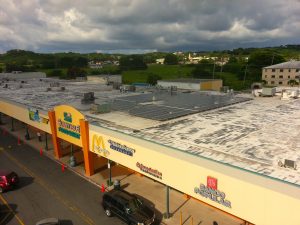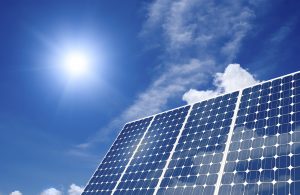Net metering is a policy that allows businesses and homeowners to receive the full retail value for the electricity that their solar energy system produces. The term net metering refers to the method of accounting for the photovoltaic (PV) system's electricity production. Net metering allows utility customers with PV systems to use any excess electricity they produce to offset their electric bill. When a net metered PV system produces electricity, the kilowatts are first used for any electric load in the structure. If the PV system produces more electricity than the structure needs, the extra kilowatts are fed into the utility grid.
In short, no. HOA's, cities and counties in the state of North Carolina do not have the authority to prevent a homeowner in a detached single-family residence from installing solar panels on their roof. HOA's, cities and counties do have the authority to screen the solar panel installation location. The allowed screening of the installation location cannot prevent reasonable use of the solar equipment.
Example: The front, street facing side of your home faces south and is the most ideal location to install solar panels on your roof. Your HOA may attempt to illegally prohibit the installation of solar panels on the street facing roof. While the HOA cannot legally stop you from installing solar on the front of your home they may attempt to force you to install the solar panels on the back side of your home; facing north. As it is not advised to install solar panels on a north facing surface (facing away from the sun) due to low energy production this location is not suitable and the HOA must allow for the installation of solar panels on the front of the home.
Click Here to read NC Senate Bill 670 that details the legal language for limitations on regulating solar collectors.
The size of your solar energy system depends on several factors including how much electricit you use, and how much space is avilable (roof or ground). The solar energy system can be built to supplement all or just a portion of your energy usage (depending on your goals). SolFarm's team can quickly work through these factors with you to determine what system would best suit your individual needs.
The price of solar energy is quickly reducing; however, there is no single or simple answer to this. Solar rebates, tax credits, and other financial incentives can greatly reduce the cost of a PV system. This cost depends on a number of factors, such as whether it is a stand-alone system or is integrated into the building design, the size of the system, and the particular system manufacturer. For solar water heaters and space heaters, you also have to consider the price of the fuel used to back up the system. In most cases, you would have to add the cost of natural gas or electricity to get a more accurate estimate of how much you can expect to pay for a solar energy system.
Your savings will depend on how much you pay your utility for electricity or natural gas, and how much your utility will pay you for any excess power that you generate with your solar energy system. SolFarms’s software analytical tools can predict what your new solar energy system will produce on an annual basis and compare that number to your annual electricity or hot water demand to get an idea of how much you will save.
A photovoltaic (PV) system needs unobstructed access to the sun's rays for most or all of the day. Shading on the system can significantly reduce energy output. Climate is not really a concern, because PV systems are relatively unaffected by severe weather.

A PV system is made up of different components. These include PV modules (groups of PV cells), which are commonly called PV panels; one or more batteries; a charge regulator or controller for a stand-alone system; an inverter for a utility-grid-connected system and when alternating current (ac) rather than direct current (dc) is required; wiring; and mounting hardware or a framework.
A PV system that is designed, installed, and maintained well will operate for decades. The basic PV module (interconnected, enclosed panel of PV cells) has no moving parts and can last more than 30 years. The best way to ensure and extend the life and effectiveness of your PV system is by having it installed and maintained properly. Experience has shown that most problems occur because of poor or sloppy system installation.
There are four main types of solar energy technologies:
- Photovoltaic (PV) systems, which convert sunlight directly to electricity by means of PV cells made of semiconductor materials.
- Concentrating solar power (CSP) systems, which concentrate the sun's energy using reflective devices such as troughs or mirror panels to produce heat that is then used to generate electricity.
- Solar water heating systems, which contain a solar collector that faces the sun and either heats water directly or heats a "working fluid" that, in turn, is used to heat water.
- Transpired solar collectors, or "solar walls," which use solar energy to preheat ventilation air for a building.
 PV can be used to power a structure’s entire electrical system, including lights, cooling systems, and appliances in the home. PV systems today can be blended easily into both traditional and nontraditional structures. In the Caribbean modules can be mounted on a south, west, or east-facing roofs.
PV can be used to power a structure’s entire electrical system, including lights, cooling systems, and appliances in the home. PV systems today can be blended easily into both traditional and nontraditional structures. In the Caribbean modules can be mounted on a south, west, or east-facing roofs.
 PV systems can be blended into virtually every conceivable structure for commercial buildings. A PV system with storage and back up generation is know as a microgrid. Microgrids for commercial structures can be connected to the utility or function independently of the utility.
PV systems can be blended into virtually every conceivable structure for commercial buildings. A PV system with storage and back up generation is know as a microgrid. Microgrids for commercial structures can be connected to the utility or function independently of the utility.
Commercial facilities in the Carolinas can produce 100% of their required energy at a cost well below utility supplied power and stabilize their energy cost for decades. An independent renewable energy system or microgrid can employ and combine a variety of technologies to deliver 24/7/365 reliable electrical power; PV, wind (if available), electric storage, combined heat and power (CHP) for cooling and hot water, and fossil fuel backup generation (piston diesel or micro turbines). These systems help businesses meet solfarm-solar-delivered-virgin-island-commercialand exceed their long-term sustainability goals.
People decide to buy solar energy systems for a variety of reasons. For example, some individuals buy solar products to preserve the Earth's finite fossil-fuel resources and to reduce air pollution. Others would rather spend their money on an energy-producing improvement to their property than send their money to a utility. Some people like the security of reducing the amount of electricity they buy from their utility, because it makes them less vulnerable to future increases in the price of electricity.
If it's designed correctly, a solar system can provide power during a utility power outage, thereby adding power reliability to your business or home. Finally, sometimes a location is outside the service area of the local utility and a solar system with storage is the only way reliable 24/7 power can be obtained.
SolFarm works with its clients to establish the design criteria for each system. Our NABCEP certified team has years of experience designing and installing solar electric systems. PV systems have few moving parts, so they require little maintenance. The components are designed to meet strict dependability and durability standards so they can stand up to the elements. Our team works with you to first evaluate the energy efficiency of your business or home to identify way to reduce your electrical load. This improves the building’s energy usage and often reduces the size and capital cost of the renewable energy system required. This is especially import if your structure is not yet designed or built, it is important to make the building as energy efficient as possible to reduce your PV system's energy requirements.
 When a semiconducting material, such certain kinds of silicon, are exposed to sunlight, they release small amounts of electricity. This process is known as the photoelectric effect. The photoelectric effect refers to the emission, or ejection, of electrons from the surface of a metal in response to light. It is the basic physical process in which a solar electric or photovoltaic (PV) cell converts sunlight to electricity.
When a semiconducting material, such certain kinds of silicon, are exposed to sunlight, they release small amounts of electricity. This process is known as the photoelectric effect. The photoelectric effect refers to the emission, or ejection, of electrons from the surface of a metal in response to light. It is the basic physical process in which a solar electric or photovoltaic (PV) cell converts sunlight to electricity.
Sunlight is made up of photons, or particles of solar energy. Photons contain various amounts of energy, corresponding to the different wavelengths of the solar spectrum. When photons strike a PV cell, they may be reflected or absorbed, or they may pass right through. Only the absorbed photons generate electricity. When this happens, the energy of the photon is transferred to an electron in an atom of the PV cell (which is actually a semiconductor).
With its newfound energy, the electron escapes from its normal position in an atom of the semiconductor material and becomes part of the current in an electrical circuit. By leaving its position, the electron causes a hole to form. Special electrical properties of the PV cell—a built-in electric field—provide the voltage needed to drive the current through an external load (such as a light bulb).










